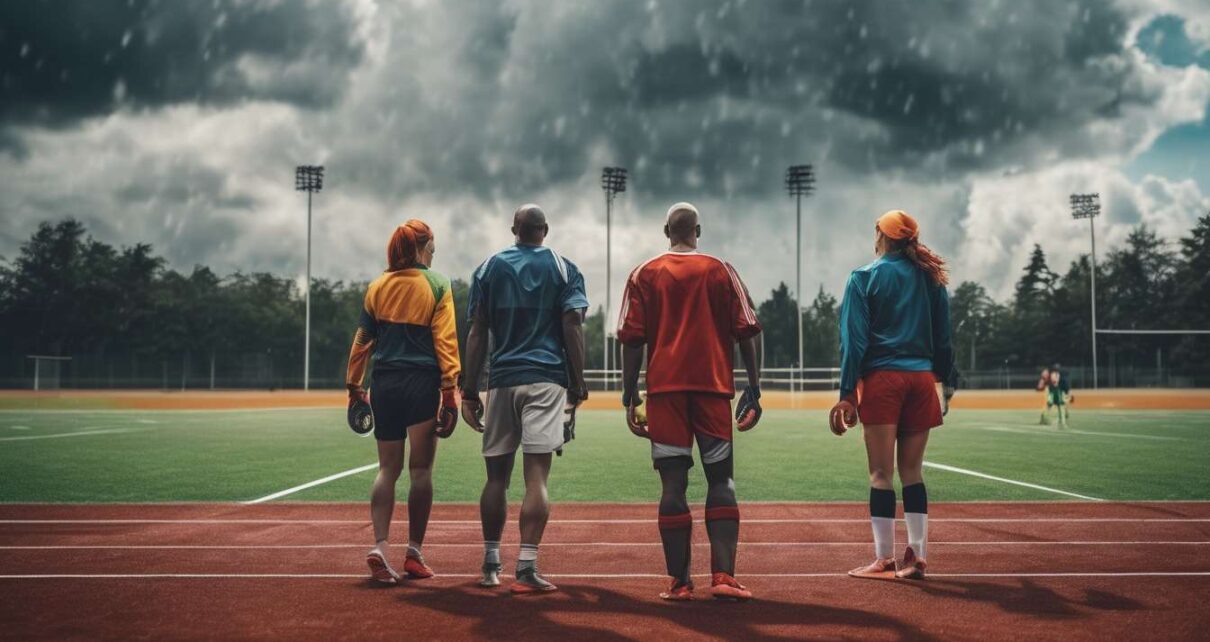As sports enthusiasts, we all know the thrill of stepping onto the field or court, ready to give our best performance. However, one factor that often plays an unpredictable role in our athletic endeavors is the weather.
Whether we’re weekend warriors or professional athletes, understanding how the elements can impact our games is crucial. In this article, we delve into the intersection of weather and sports, exploring ten practical considerations that can help us prepare for whatever Mother Nature throws our way.
From the sweltering heat of summer tournaments to the biting cold of winter matches, we must adapt our strategies and gear to maintain peak performance and safety. By examining how factors like humidity, wind, and precipitation affect different sports, we aim to equip ourselves with the knowledge needed to stay ahead in any conditions.
Join us as we navigate the dynamic relationship between weather and sports.
-
Understand Temperature Extremes:
- Adjust hydration strategies for hot weather.
- Layer clothing for insulation in cold conditions.
-
Account for Humidity:
- Recognize its impact on endurance and performance.
- Plan for increased sweat and the need for more hydration.
-
Adapt to Wind Conditions:
- Modify techniques in sports like golf or soccer.
- Use wind direction to your advantage when possible.
-
Prepare for Precipitation:
- Wear appropriate footwear to prevent slipping.
- Consider equipment that handles wet conditions better.
-
Monitor Weather Forecasts:
- Stay updated on changes that could affect game day.
- Make contingency plans for severe weather.
-
Utilize Appropriate Gear:
- Invest in weather-resistant clothing and equipment.
- Ensure gear is suitable for specific weather conditions.
-
Warm-Up and Cool Down Properly:
- Adjust routines based on temperature and weather.
- Pay attention to muscle care in extreme conditions.
-
Consider Altitude and Air Pressure:
- Be aware of how these factors can affect breathing and performance.
- Prepare for different conditions if traveling to higher altitudes.
-
Hydration and Nutrition:
- Adapt intake based on weather demands.
- Focus on electrolyte balance in extreme temperatures.
-
Safety First:
- Know the signs of weather-related health issues like heatstroke or hypothermia.
- Prioritize safety over competition in dangerous conditions.
By keeping these considerations in mind, we can better prepare ourselves for the challenges posed by the weather, ensuring we maintain both performance and safety.
Temperature Adaptation
Adapting to Varying Temperatures for Optimal Performance
As a community of sports enthusiasts, we recognize that feeling comfortable and confident is key to enhancing athletic performance. By understanding how temperature, humidity, and wind affect our bodies, we can better prepare and support each other.
Cooler Temperatures Adaptation:
- In cooler temperatures, our muscles might require a longer warm-up to prevent injuries.
- Dress in layers to maintain the right body heat, shedding them as we get warmer.
High Temperatures Adaptation:
- Stay hydrated by drinking plenty of fluids.
- Take regular breaks to prevent overheating.
- Incorporate cooling strategies such as:
- Ice packs
- Cooling vests during breaks
Wind Adaptation:
- Wind can either be an ally or an adversary:
- When it pushes against us, it demands more energy.
- When at our backs, it can propel us forward.
Community Support:
Together, we can tackle these challenges, ensuring we all thrive, no matter the conditions. Let’s stay connected and share our strategies to enhance our performance across different environments.
Humidity Impact
Our performance can be significantly affected by varying levels of humidity, making it crucial to adapt our strategies accordingly.
High Humidity:
- When we face high humidity, the air feels heavy, and our bodies struggle to cool down, even if the temperature isn’t extremely high.
- This can lead to quicker fatigue and dehydration.
- To counter these effects, it’s important to:
- Stay hydrated
- Pace ourselves wisely
Low Humidity:
- Low humidity might make us feel cooler, but it can dry out our skin and airways.
In sports, understanding how humidity and temperature impact performance is essential.
- Adjust training schedules to avoid peak heat and humidity by opting for early mornings or late evenings.
- Use proper gear like moisture-wicking clothing to help manage sweat and maintain comfort.
Additional Considerations:
- While humidity and temperature are key factors, wind can also play a role in our experience, which we’ll explore further next.
Together, we can conquer any weather challenges on the field.
Wind Adjustment
Navigating windy conditions requires us to adjust our strategies to maintain control and optimize performance. Wind can dramatically alter the trajectory of a ball or the pace of a race. We must embrace these challenges and adapt, ensuring we’re ready for whatever nature throws our way.
Understanding the Elements:
- By understanding the interplay between temperature, humidity, and wind, we can better prepare ourselves for the elements.
When the wind picks up, consider:
-
Direction and Speed: Determine how the wind interacts with temperature and humidity.
-
Adjustments:
- A cold, dry wind might require adjustments to our grip.
- A warm, humid breeze could affect our stamina.
Team Sports:
- Communicating effectively and supporting each other becomes essential.
- Sharing insights about wind patterns helps us make informed decisions on the field.
Together, we can harness the power of the wind to our advantage, turning potential obstacles into opportunities for growth and camaraderie. Let’s face the wind head-on!
Handling Precipitation
When rain starts to fall, we need to quickly adapt our strategies to ensure safety and maintain performance.
Impact of Precipitation on Playing Surface:
- Wet conditions often lead to slippery fields.
- Adjust footwear for better traction.
- Cleats designed for wet environments can be a game-changer.
- Helps in staying grounded and agile.
Temperature Considerations:
- Colder rain can decrease body temperature rapidly.
- Layer with moisture-wicking materials to stay warm without sacrificing mobility.
- Consider humidity, which affects how the air feels.
- Clothing choices should account for these variations to maintain comfort and focus.
Wind Factors:
- Wind can alter the trajectory of a ball or affect balance.
- Analyze wind patterns to adjust techniques.
- Ensures competitiveness and safety in all weather conditions.
Together, we face the rain as a team, adapting our strategies to maintain our performance and safety.
Weather Forecast Management
Accurate weather forecasting allows us to proactively adjust our game plans, ensuring we’re prepared for any conditions. As a team, it’s essential we stay informed about the temperature, humidity, and wind patterns that could impact our performance. By understanding these elements, we can strategize effectively and support each other in overcoming any weather-related challenges.
Temperature Considerations:
- When the temperature rises, we need to plan for hydration and pacing.
- Ensuring everyone feels their best is crucial under high temperatures.
Humidity Challenges:
- High humidity can make the air feel heavier and impact our stamina.
- Together, we can devise strategies to maintain energy levels and encourage each other throughout the game.
Wind Factors:
- Wind can be unpredictable, affecting the trajectory of a ball or the speed of a run.
- By anticipating these shifts, we can adapt our tactics to stay one step ahead.
Monitoring weather conditions fosters a sense of unity among us, reinforcing the idea that we’re all in this together, no matter the forecast.
Gear Selection
Choosing the right gear is crucial for optimizing our performance and comfort in varying weather conditions.
When temperatures drop, we need to layer up with breathable fabrics that trap body heat yet allow sweat to escape, preventing us from becoming uncomfortably damp.
In contrast, high temperatures and humidity call for lightweight, moisture-wicking materials to keep us cool and dry.
It’s important to remember that our gear should adapt not only to the thermometer but also to the wind.
A strong wind can make a mild day feel much colder, so windproof jackets or vests are a smart choice to shield us from the chill. For those breezy days, let’s not forget accessories like hats and gloves, which help maintain body warmth.
Additionally, shoes with the right grip are essential when we’re dealing with wet, slippery surfaces.
By mindfully selecting our gear, we’re not just preparing for the weather; we’re ensuring that we can perform at our best together.
Proper Warm-Up and Cool Down
An effective warm-up and cool down are vital for enhancing our performance and reducing the risk of injury.
We all know that feeling of unity when we prepare together, ensuring our bodies are ready for the challenges ahead. Considering temperature, humidity, and wind is essential in crafting our warm-up routine.
Weather Considerations:
-
On a chilly, windy day:
- Engage in dynamic movements to increase core temperature swiftly.
- This helps us feel connected and prepared, despite the biting wind.
-
Humidity’s role:
- In high humidity, our bodies might warm up faster but cool down slower.
- We should pace our cool-down, allowing our heart rates to gradually return to normal.
Community and Adaptation:
This shared experience fosters a sense of camaraderie, as we support each other’s recovery. Together, we can adapt our routines to weather conditions, fostering a stronger community bond.
Let’s embrace these moments, ensuring we’re all ready to perform our best and feel our best.
Altitude and Pressure Awareness
Performance and Endurance at Altitude
Our performance and endurance can be significantly affected by altitude and atmospheric pressure changes.
When we’re at higher altitudes, the air pressure drops, and there’s less oxygen available. This can make breathing a challenge, especially during intense activities. We might notice that our usual pace feels tougher to maintain.
Temperature Effects
- Cooler temperatures at higher altitudes can impact our muscles and energy levels.
Humidity Considerations
Humidity is another factor we shouldn’t overlook. The air’s moisture content can vary significantly with altitude, affecting how our bodies cool down.
- At lower humidity levels, sweat evaporates faster, which might help with cooling but could also lead to quicker dehydration.
Wind Influence
Wind, too, can be a double-edged sword; while it can cool us down, it might also make us feel colder than expected, especially when combined with lower temperatures.
Preparation and Adaptation
By understanding these elements, we can better prepare, ensuring our group thrives and supports each other in any environment.
How does seasonal change affect the scheduling of sports events?
Seasonal change significantly impacts sports event scheduling.
As we navigate through different times of the year, factors like weather conditions and daylight hours play a crucial role in determining when games can be held.
These changes often require organizations to adapt their calendars to ensure the safety and enjoyment of athletes and spectators alike.
It’s essential to consider these aspects when planning sporting events to guarantee a successful and enjoyable experience for everyone involved.
What are the psychological effects of weather changes on athletes’ performance?
Weather and Psychological Effects on Athletes:
Weather changes can significantly affect athletes’ performance by impacting their:
- Mood
- Motivation
- Physical abilities
Understanding and Coping with Weather Effects:
-
Acknowledge the Impact: Recognize how different weather conditions can alter an athlete’s psychological state.
-
Develop Coping Strategies: Implement techniques to maintain focus and motivation during unfavorable weather conditions.
By addressing these psychological impacts, athletes can better optimize their performance regardless of weather conditions. This proactive approach supports maintaining peak performance levels in sports.
How do different climates influence the popularity of certain sports in various regions?
Different climates greatly impact the popularity of sports in various regions. Our preferences are shaped by the environment we live in.
For instance, colder regions might favor sports such as:
- Ice hockey
- Skiing
In contrast, warmer areas may lean towards sports like:
- Soccer
- Surfing
These climate-driven choices not only reflect our local culture but also offer a sense of identity and community through shared interests and activities.
Conclusion
In conclusion, always consider the weather’s impact on your sports performance. By adapting to various conditions, you can optimize your athletic output.
Key factors to consider:
- Temperature
- Humidity
- Wind
- Precipitation
Steps to manage weather impacts:
-
Manage forecasts: Regularly check weather updates to plan your training or competition.
-
Select appropriate gear: Choose clothing and equipment suited to the weather conditions.
-
Be mindful of altitude and pressure: Understand how these factors can influence your performance.
Additional Tips:
-
Prioritize proper warm-up and cool-down routines to prevent injuries and enhance recovery.
-
Stay aware and prepared for all weather conditions to excel in your sports endeavors.
By incorporating these strategies, you can maintain peak performance regardless of weather challenges.




